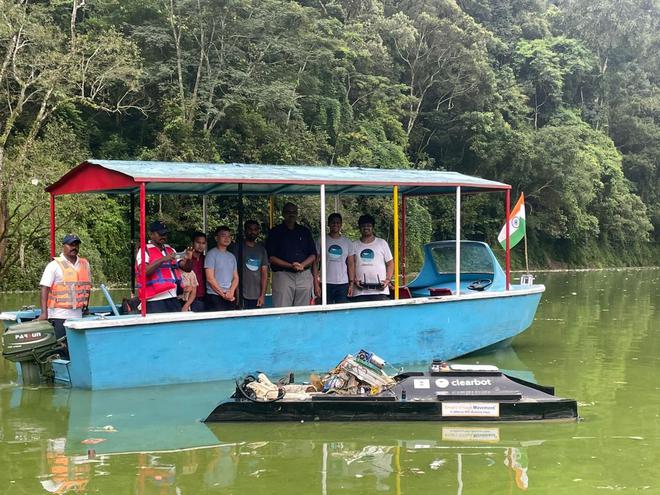Waste collection from a lake at an altitude of about 4,900 ft in Meghalaya has gone robotic.
An artificial intelligence-integrated robotic boat collected 250 kg of garbage in less than three hours of swim time from Umiam Lake, a reservoir for a hydropower project and a tourist spot lake 20 km from the State’s capital Shillong on Friday, August 25.
Its deployment was a collaboration among the Meghalaya government, a global non-profit organisation called Smart Village Movement (SVM), and Hong Kong-based technology firm Clearbot after a week-long demonstration.

Various stakeholders crucial to the Umiam Lake were invited to witness the potential of the robotic boat, an outcome of cutting-edge technology, to “revolutionise waste collection”. The demonstration at Kyndong Rella in the Mawdun area of the lake was the first such initiative in the northeast.
Tested in Bali
“We are using this technology, first tested in Indonesia’s Bali, to deal with waste collection at a touristic site. We hope such models will create standard processes to handle waste in a timely manner, making operations more efficient than conventional ones,” Tulenam Laloo, a fellow at the University of California, Berkeley said.
“Such technologies must be leveraged to a great extent to address the growing menace of waste and help scale such models to similar locations,” Mr Laloo, also the director of operations for the SVM in Meghalaya, said.
Siddhant Gupta, the founder of Clearbot said the pilot project was aimed at demonstrating how technology-driven clean-up initiatives can contribute to holistic rural development aligned with the SVM’s vision for a sustainable future.
“We are excited to join forces with the SVM to revitalise local waterways in Meghalaya. This partnership exemplifies our commitment to innovative solutions for environmental rejuvenation,” he said.
Ramkumar S., a bureaucrat and nodal officer of the SVM said the robotic initiative is aligned with the Meghalaya government’s commitment to foster a cleaner and more sustainable environment through technology-driven solutions.
Local fishermen have been complaining about their inability to reach many parts of Umaim Lake due to the accumulation of waste.
“The technology presents an economical method for effectively removing debris and oil while operating on electric power. With the capacity to gather as much as 15 litres of oil and 200 kg of floating refuse daily, these models need to be explored in our State,” Pynshai Marpna, the project lead for Friday’s demonstration said.
Among the stakeholders who were present during the demonstration were officials of the Meghalaya Energy Corporation Limited, the Meghalaya Tourism Development Corporation, the local municipal authority, and the headman and community elders of Mawdun village.







